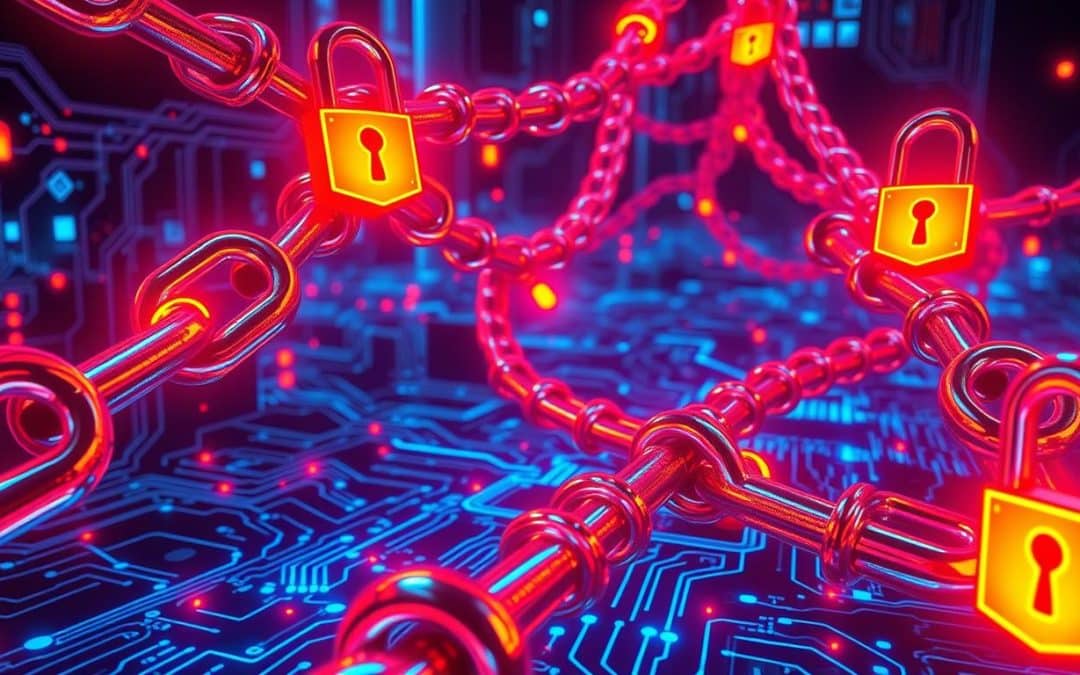Blockchain security is crucial for protecting digital assets and networks in our increasingly digital world. This guide explores key aspects of blockchain security, from cryptographic techniques to emerging threats and best practices.
Key Takeaways
- Blockchain’s decentralized architecture offers a unique approach to securing digital assets and networks.
- Cybercrime costs are projected to reach $10.5 trillion annually by 2025, highlighting the critical need for robust blockchain security measures.
- Understanding common security threats, such as 51% attacks and smart contract vulnerabilities, is crucial for developing effective blockchain security protocols.
- Cryptographic techniques, consensus mechanisms, and emerging technologies like AI play a vital role in enhancing blockchain security.
- Regulatory frameworks surrounding blockchain security are evolving, and organizations must stay informed to ensure compliance.
Understanding Blockchain Technology
Blockchain is a distributed ledger technology that securely records transactions and data across a decentralized network. Key features include:
- Decentralization: No single controlling entity
- Transparency: All transactions visible to network participants
- Immutability: Data cannot be altered once recorded
There are two main types of blockchain networks: public (open to anyone) and private (restricted access).
The Importance of Blockchain Security
Robust security is essential for protecting digital assets and maintaining trust in blockchain networks. Recent data shows:
- Cryptocurrency hacks reached $2.2 billion in 2025, up 21.07% from 2023
- Private key compromises caused 43.8% of stolen funds in 2025
- North Korean hackers stole $1.34 billion in 47 hacking instances
Common Security Threats to Blockchain
Major security risks include:
- 51% attacks: Controlling majority of network’s computing power
- Double-spending: Attempting to spend the same digital asset multiple times
- Smart contract vulnerabilities: Flaws in self-executing code
Real-world examples like the DAO hack on Ethereum highlight the need for thorough security measures.
Protocols and Practices for Securing Blockchain
Best practices for blockchain security include:
- Thorough code audits to identify vulnerabilities
- Implementing multi-signature wallets for critical transactions
- Formal verification of smart contracts
- Robust access control mechanisms
- Comprehensive testing of contract logic
Cryptographic Techniques in Blockchain Security
Cryptography is fundamental to blockchain security:
- Public-key cryptography ensures secure transactions
- Hash functions maintain data integrity and create the blockchain
- Digital signatures authenticate transactions and establish non-repudiation
Regulatory Frameworks Surrounding Blockchain Security
The regulatory landscape for blockchain security is complex and evolving:
- U.S. agencies like SEC and CFTC have issued guidelines on digital assets
- Global regulations vary significantly between countries
- Balancing compliance with blockchain principles remains challenging
The Role of Consensus Mechanisms in Security
Consensus mechanisms are vital for blockchain security:
- Proof of Work (PoW) relies on computational puzzles for validation
- Proof of Stake (PoS) uses participants’ existing stakes
- Each mechanism has unique security implications
Emerging Technologies Enhancing Blockchain Security
New technologies are improving blockchain security:
- AI can detect threats 40,000 times faster than traditional methods
- Quantum-resistant algorithms are being developed to counter future threats
- Advanced cryptographic techniques like homomorphic encryption show promise
Future Trends in Blockchain Security
The future of blockchain security will likely involve:
- Continued evolution of security protocols
- Proactive approaches to emerging threats
- Integration of advanced cryptographic techniques
- Ongoing adaptation to regulatory changes
By understanding and implementing robust security measures, we can ensure the continued growth and adoption of blockchain technology across various industries.

